Pueblo vs Arapaho Community Comparison
COMPARE
Pueblo
Arapaho
Social Comparison
Social Comparison
Pueblo
Arapaho
2,100
SOCIAL INDEX
18.5/ 100
SOCIAL RATING
270th/ 347
SOCIAL RANK
2,537
SOCIAL INDEX
22.9/ 100
SOCIAL RATING
252nd/ 347
SOCIAL RANK
Arapaho Integration in Pueblo Communities
The statistical analysis conducted on geographies consisting of 21,986,910 people shows a strong positive correlation between the proportion of Arapaho within Pueblo communities in the United States with a correlation coefficient (R) of 0.728. On average, for every 1% (one percent) increase in Pueblo within a typical geography, there is an increase of 0.025% in Arapaho. To illustrate, in a geography comprising of 100,000 individuals, a rise of 1,000 Pueblo corresponds to an increase of 25.1 Arapaho.
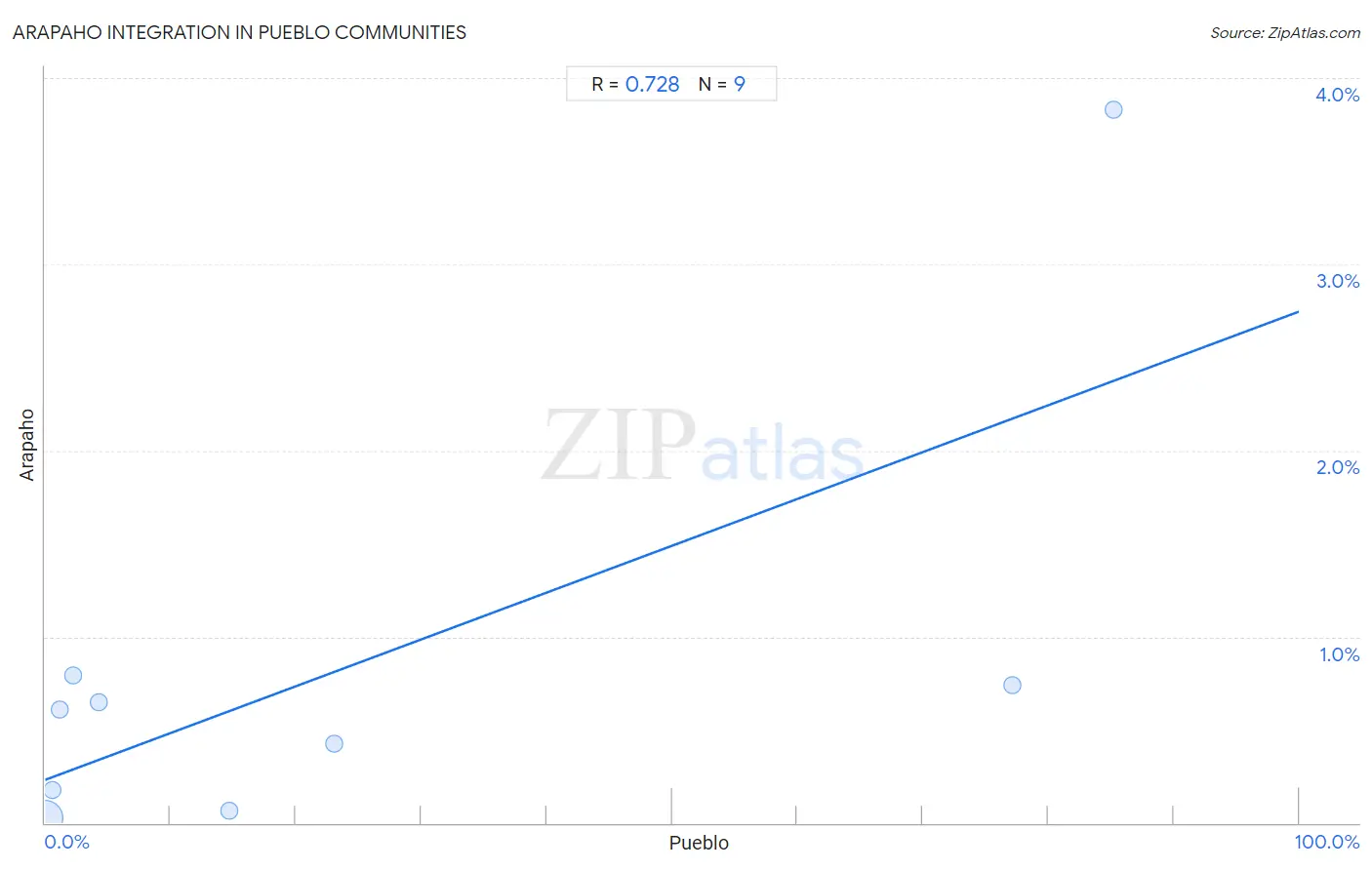
Pueblo vs Arapaho Income
When considering income, the most significant differences between Pueblo and Arapaho communities in the United States are seen in wage/income gap (20.7% compared to 23.5%, a difference of 13.5%), householder income over 65 years ($52,930 compared to $59,383, a difference of 12.2%), and median family income ($76,880 compared to $82,064, a difference of 6.7%). Conversely, both communities are more comparable in terms of householder income ages 45 - 64 years ($75,601 compared to $75,945, a difference of 0.45%), median earnings ($36,859 compared to $36,586, a difference of 0.75%), and per capita income ($32,012 compared to $32,345, a difference of 1.0%).

| Income Metric | Pueblo | Arapaho |
| Per Capita Income | Tragic $32,012 | Tragic $32,345 |
| Median Family Income | Tragic $76,880 | Tragic $82,064 |
| Median Household Income | Tragic $64,692 | Tragic $67,965 |
| Median Earnings | Tragic $36,859 | Tragic $36,586 |
| Median Male Earnings | Tragic $41,314 | Tragic $41,758 |
| Median Female Earnings | Tragic $32,564 | Tragic $31,489 |
| Householder Age | Under 25 years | Tragic $45,018 | Tragic $44,003 |
| Householder Age | 25 - 44 years | Tragic $68,910 | Tragic $71,697 |
| Householder Age | 45 - 64 years | Tragic $75,601 | Tragic $75,945 |
| Householder Age | Over 65 years | Tragic $52,930 | Poor $59,383 |
| Wage/Income Gap | Exceptional 20.7% | Exceptional 23.5% |
Pueblo vs Arapaho Poverty
When considering poverty, the most significant differences between Pueblo and Arapaho communities in the United States are seen in married-couple family poverty (11.1% compared to 6.6%, a difference of 69.3%), seniors poverty over the age of 65 (17.2% compared to 11.6%, a difference of 47.7%), and receiving food stamps (19.9% compared to 14.1%, a difference of 41.1%). Conversely, both communities are more comparable in terms of single male poverty (21.6% compared to 21.9%, a difference of 1.5%), child poverty under the age of 5 (23.7% compared to 23.1%, a difference of 2.4%), and female poverty among 18-24 year olds (26.9% compared to 25.2%, a difference of 6.9%).
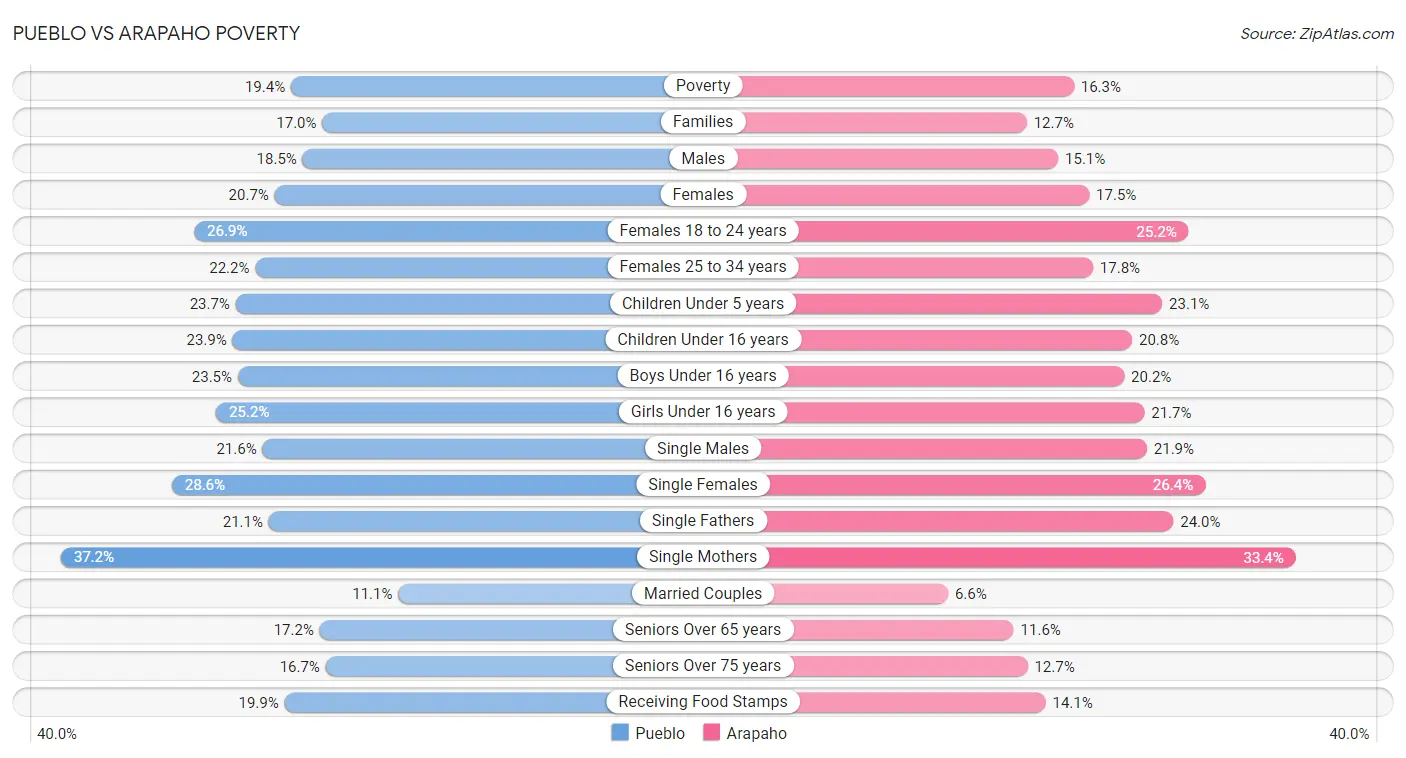
| Poverty Metric | Pueblo | Arapaho |
| Poverty | Tragic 19.4% | Tragic 16.3% |
| Families | Tragic 17.0% | Tragic 12.7% |
| Males | Tragic 18.5% | Tragic 15.1% |
| Females | Tragic 20.7% | Tragic 17.5% |
| Females 18 to 24 years | Tragic 26.9% | Tragic 25.2% |
| Females 25 to 34 years | Tragic 22.2% | Tragic 17.8% |
| Children Under 5 years | Tragic 23.7% | Tragic 23.1% |
| Children Under 16 years | Tragic 23.9% | Tragic 20.8% |
| Boys Under 16 years | Tragic 23.5% | Tragic 20.2% |
| Girls Under 16 years | Tragic 25.2% | Tragic 21.7% |
| Single Males | Tragic 21.6% | Tragic 21.9% |
| Single Females | Tragic 28.6% | Tragic 26.4% |
| Single Fathers | Tragic 21.1% | Tragic 24.0% |
| Single Mothers | Tragic 37.2% | Tragic 33.4% |
| Married Couples | Tragic 11.1% | Tragic 6.6% |
| Seniors Over 65 years | Tragic 17.2% | Tragic 11.6% |
| Seniors Over 75 years | Tragic 16.7% | Poor 12.7% |
| Receiving Food Stamps | Tragic 19.9% | Tragic 14.1% |
Pueblo vs Arapaho Unemployment
When considering unemployment, the most significant differences between Pueblo and Arapaho communities in the United States are seen in unemployment among women with children under 6 years (9.1% compared to 19.0%, a difference of 108.9%), unemployment among women with children ages 6 to 17 years (8.6% compared to 16.8%, a difference of 94.9%), and unemployment among ages 30 to 34 years (8.3% compared to 12.8%, a difference of 55.0%). Conversely, both communities are more comparable in terms of unemployment among ages 65 to 74 years (5.6% compared to 5.8%, a difference of 3.3%), unemployment among seniors over 65 years (5.4% compared to 5.3%, a difference of 3.4%), and unemployment among seniors over 75 years (7.7% compared to 8.1%, a difference of 4.1%).
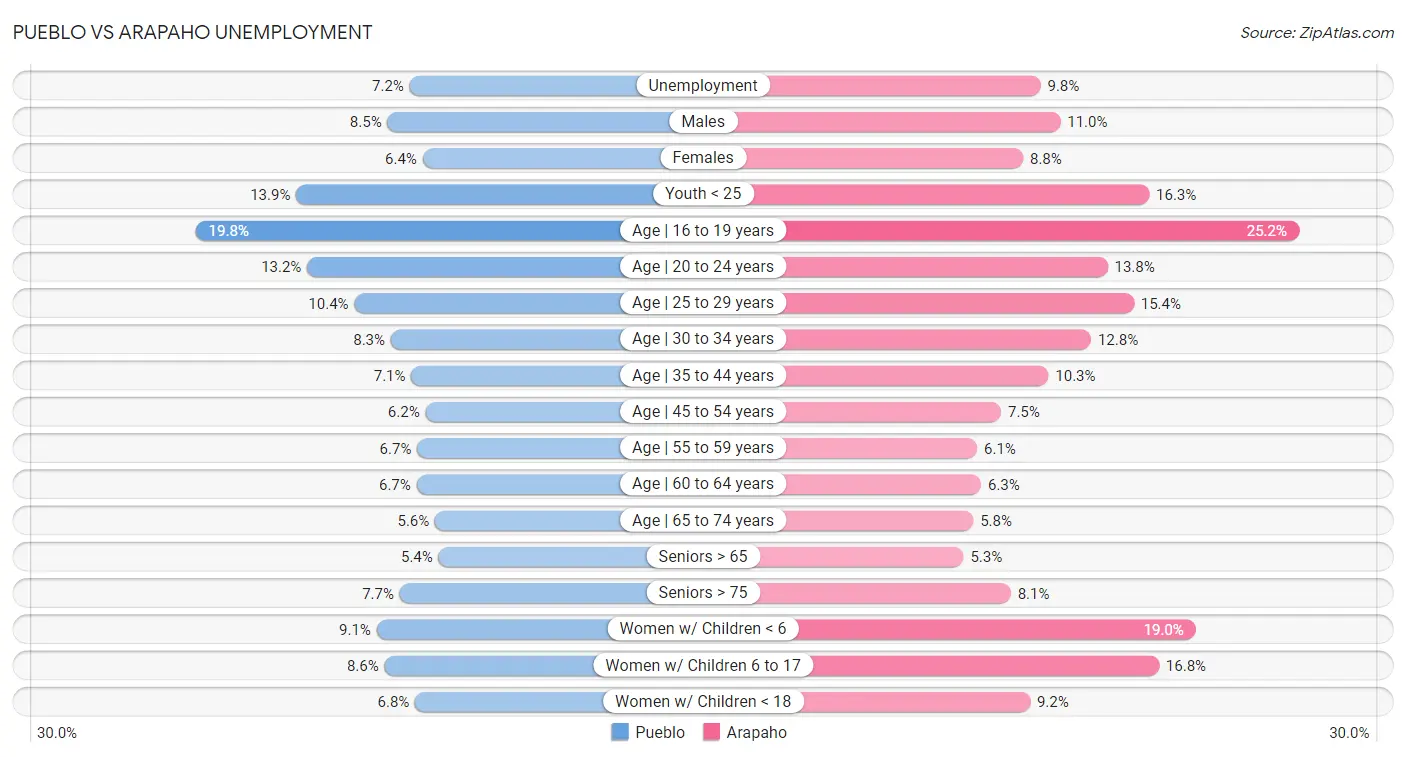
| Unemployment Metric | Pueblo | Arapaho |
| Unemployment | Tragic 7.2% | Tragic 9.8% |
| Males | Tragic 8.5% | Tragic 11.0% |
| Females | Tragic 6.4% | Tragic 8.8% |
| Youth < 25 | Tragic 13.9% | Tragic 16.3% |
| Age | 16 to 19 years | Tragic 19.8% | Tragic 25.2% |
| Age | 20 to 24 years | Tragic 13.2% | Tragic 13.8% |
| Age | 25 to 29 years | Tragic 10.4% | Tragic 15.4% |
| Age | 30 to 34 years | Tragic 8.3% | Tragic 12.8% |
| Age | 35 to 44 years | Tragic 7.1% | Tragic 10.3% |
| Age | 45 to 54 years | Tragic 6.2% | Tragic 7.5% |
| Age | 55 to 59 years | Tragic 6.7% | Tragic 6.1% |
| Age | 60 to 64 years | Tragic 6.7% | Tragic 6.3% |
| Age | 65 to 74 years | Tragic 5.6% | Tragic 5.8% |
| Seniors > 65 | Tragic 5.4% | Tragic 5.3% |
| Seniors > 75 | Exceptional 7.7% | Exceptional 8.1% |
| Women w/ Children < 6 | Tragic 9.1% | Tragic 19.0% |
| Women w/ Children 6 to 17 | Exceptional 8.6% | Tragic 16.8% |
| Women w/ Children < 18 | Tragic 6.8% | Tragic 9.2% |
Pueblo vs Arapaho Labor Participation
When considering labor participation, the most significant differences between Pueblo and Arapaho communities in the United States are seen in in labor force | age 16-19 (34.9% compared to 37.3%, a difference of 6.8%), in labor force | age > 16 (59.3% compared to 62.1%, a difference of 4.9%), and in labor force | age 20-64 (72.6% compared to 74.4%, a difference of 2.4%). Conversely, both communities are more comparable in terms of in labor force | age 35-44 (77.4% compared to 78.1%, a difference of 0.91%), in labor force | age 25-29 (77.5% compared to 76.6%, a difference of 1.2%), and in labor force | age 20-24 (72.9% compared to 73.8%, a difference of 1.3%).

| Labor Participation Metric | Pueblo | Arapaho |
| In Labor Force | Age > 16 | Tragic 59.3% | Tragic 62.1% |
| In Labor Force | Age 20-64 | Tragic 72.6% | Tragic 74.4% |
| In Labor Force | Age 16-19 | Tragic 34.9% | Excellent 37.3% |
| In Labor Force | Age 20-24 | Tragic 72.9% | Tragic 73.8% |
| In Labor Force | Age 25-29 | Tragic 77.5% | Tragic 76.6% |
| In Labor Force | Age 30-34 | Tragic 80.0% | Tragic 81.5% |
| In Labor Force | Age 35-44 | Tragic 77.4% | Tragic 78.1% |
| In Labor Force | Age 45-54 | Tragic 75.5% | Tragic 77.1% |
Pueblo vs Arapaho Family Structure
When considering family structure, the most significant differences between Pueblo and Arapaho communities in the United States are seen in divorced or separated (12.7% compared to 14.8%, a difference of 16.5%), births to unmarried women (53.7% compared to 47.1%, a difference of 13.9%), and single father households (3.3% compared to 2.9%, a difference of 13.9%). Conversely, both communities are more comparable in terms of family households with children (25.2% compared to 25.6%, a difference of 1.4%), family households (68.2% compared to 66.5%, a difference of 2.6%), and single mother households (7.4% compared to 7.1%, a difference of 4.0%).

| Family Structure Metric | Pueblo | Arapaho |
| Family Households | Exceptional 68.2% | Exceptional 66.5% |
| Family Households with Children | Tragic 25.2% | Tragic 25.6% |
| Married-couple Households | Tragic 40.0% | Tragic 41.8% |
| Average Family Size | Exceptional 3.79 | Exceptional 3.64 |
| Single Father Households | Tragic 3.3% | Tragic 2.9% |
| Single Mother Households | Tragic 7.4% | Tragic 7.1% |
| Currently Married | Tragic 38.2% | Tragic 40.5% |
| Divorced or Separated | Tragic 12.7% | Tragic 14.8% |
| Births to Unmarried Women | Tragic 53.7% | Tragic 47.1% |
Pueblo vs Arapaho Vehicle Availability
When considering vehicle availability, the most significant differences between Pueblo and Arapaho communities in the United States are seen in no vehicles in household (10.8% compared to 7.4%, a difference of 46.3%), 3 or more vehicles in household (23.0% compared to 26.4%, a difference of 14.8%), and 4 or more vehicles in household (8.6% compared to 9.4%, a difference of 9.0%). Conversely, both communities are more comparable in terms of 1 or more vehicles in household (89.6% compared to 92.7%, a difference of 3.5%), 2 or more vehicles in household (57.5% compared to 60.2%, a difference of 4.8%), and 4 or more vehicles in household (8.6% compared to 9.4%, a difference of 9.0%).

| Vehicle Availability Metric | Pueblo | Arapaho |
| No Vehicles Available | Fair 10.8% | Exceptional 7.4% |
| 1+ Vehicles Available | Fair 89.6% | Exceptional 92.7% |
| 2+ Vehicles Available | Exceptional 57.5% | Exceptional 60.2% |
| 3+ Vehicles Available | Exceptional 23.0% | Exceptional 26.4% |
| 4+ Vehicles Available | Exceptional 8.6% | Exceptional 9.4% |
Pueblo vs Arapaho Education Level
When considering education level, the most significant differences between Pueblo and Arapaho communities in the United States are seen in doctorate degree (1.7% compared to 1.2%, a difference of 47.2%), professional degree (3.7% compared to 2.9%, a difference of 29.4%), and no schooling completed (1.9% compared to 2.1%, a difference of 13.2%). Conversely, both communities are more comparable in terms of 4th grade (98.0% compared to 98.1%, a difference of 0.10%), 3rd grade (98.2% compared to 98.4%, a difference of 0.15%), and 2nd grade (98.3% compared to 98.5%, a difference of 0.17%).
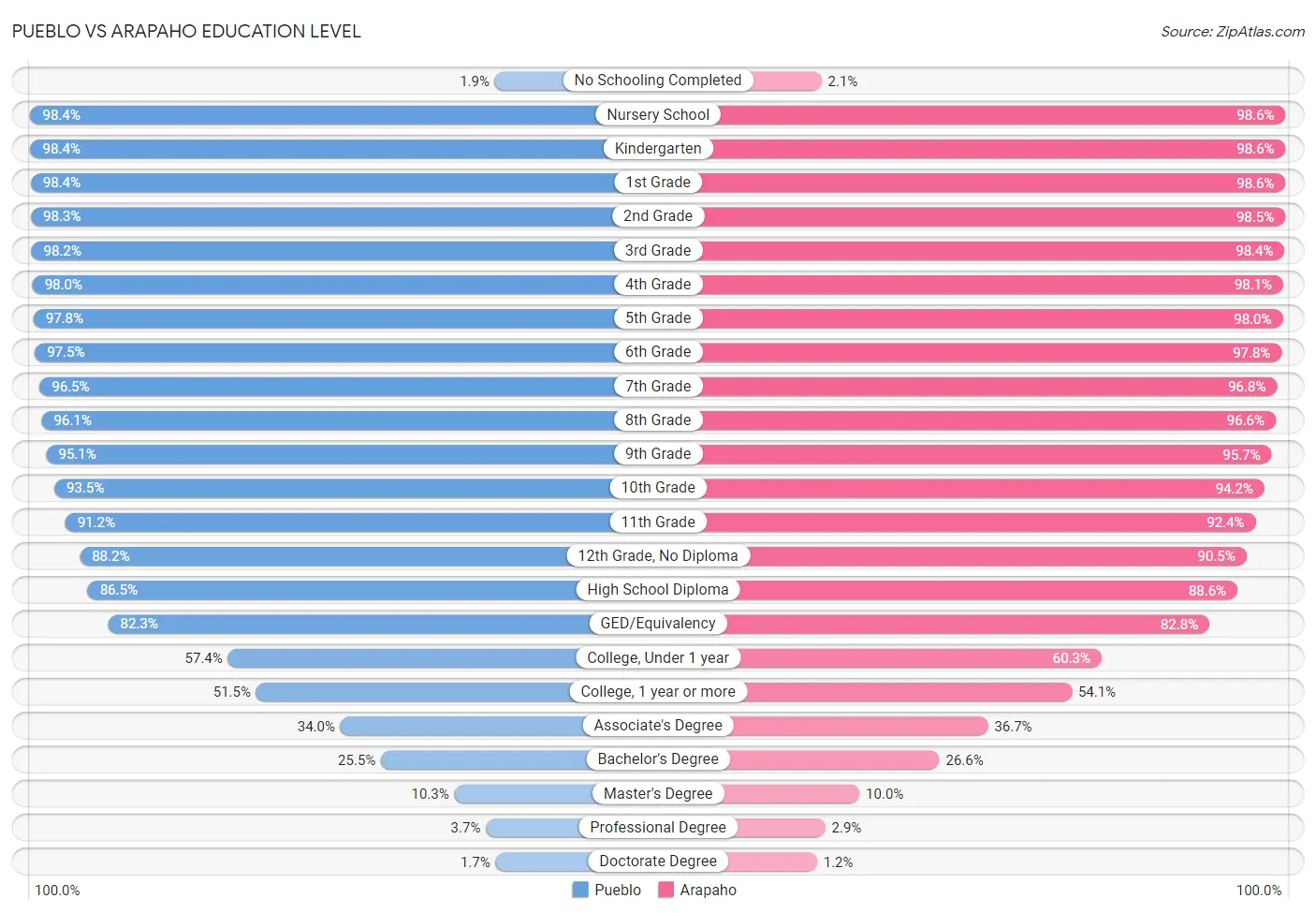
| Education Level Metric | Pueblo | Arapaho |
| No Schooling Completed | Exceptional 1.9% | Average 2.1% |
| Nursery School | Exceptional 98.4% | Exceptional 98.6% |
| Kindergarten | Exceptional 98.4% | Exceptional 98.6% |
| 1st Grade | Exceptional 98.4% | Exceptional 98.6% |
| 2nd Grade | Exceptional 98.3% | Exceptional 98.5% |
| 3rd Grade | Exceptional 98.2% | Exceptional 98.4% |
| 4th Grade | Exceptional 98.0% | Exceptional 98.1% |
| 5th Grade | Exceptional 97.8% | Exceptional 98.0% |
| 6th Grade | Exceptional 97.5% | Exceptional 97.8% |
| 7th Grade | Exceptional 96.5% | Exceptional 96.8% |
| 8th Grade | Exceptional 96.1% | Exceptional 96.6% |
| 9th Grade | Excellent 95.1% | Exceptional 95.7% |
| 10th Grade | Fair 93.5% | Exceptional 94.2% |
| 11th Grade | Tragic 91.2% | Fair 92.4% |
| 12th Grade, No Diploma | Tragic 88.2% | Tragic 90.5% |
| High School Diploma | Tragic 86.5% | Poor 88.6% |
| GED/Equivalency | Tragic 82.3% | Tragic 82.8% |
| College, Under 1 year | Tragic 57.4% | Tragic 60.3% |
| College, 1 year or more | Tragic 51.5% | Tragic 54.1% |
| Associate's Degree | Tragic 34.0% | Tragic 36.7% |
| Bachelor's Degree | Tragic 25.5% | Tragic 26.6% |
| Master's Degree | Tragic 10.3% | Tragic 10.0% |
| Professional Degree | Tragic 3.7% | Tragic 2.9% |
| Doctorate Degree | Poor 1.7% | Tragic 1.2% |
Pueblo vs Arapaho Disability
When considering disability, the most significant differences between Pueblo and Arapaho communities in the United States are seen in vision disability (3.3% compared to 2.6%, a difference of 27.7%), self-care disability (3.3% compared to 2.6%, a difference of 23.2%), and disability age 5 to 17 (5.7% compared to 4.7%, a difference of 19.6%). Conversely, both communities are more comparable in terms of disability age 35 to 64 (15.3% compared to 15.1%, a difference of 1.7%), disability age under 5 (1.3% compared to 1.3%, a difference of 4.6%), and ambulatory disability (7.6% compared to 7.1%, a difference of 6.9%).
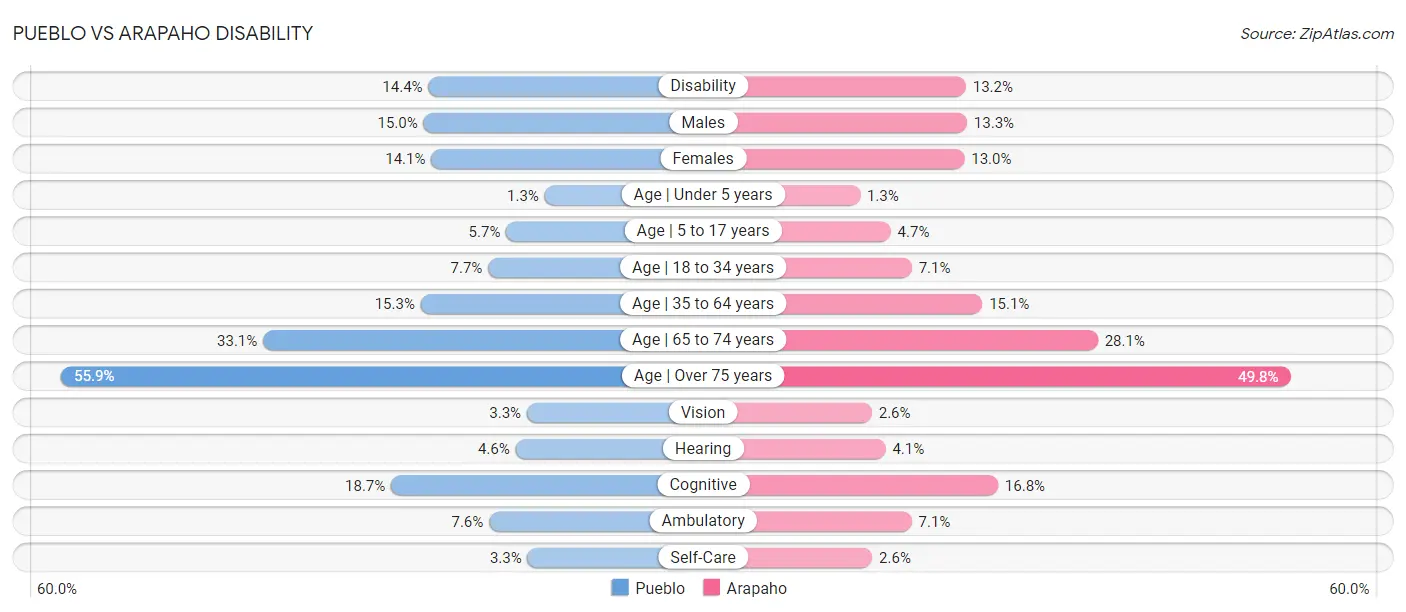
| Disability Metric | Pueblo | Arapaho |
| Disability | Tragic 14.4% | Tragic 13.2% |
| Males | Tragic 15.0% | Tragic 13.3% |
| Females | Tragic 14.1% | Tragic 13.0% |
| Age | Under 5 years | Tragic 1.3% | Fair 1.3% |
| Age | 5 to 17 years | Fair 5.7% | Exceptional 4.7% |
| Age | 18 to 34 years | Tragic 7.7% | Tragic 7.1% |
| Age | 35 to 64 years | Tragic 15.3% | Tragic 15.1% |
| Age | 65 to 74 years | Tragic 33.1% | Tragic 28.1% |
| Age | Over 75 years | Tragic 55.9% | Tragic 49.8% |
| Vision | Tragic 3.3% | Tragic 2.6% |
| Hearing | Tragic 4.6% | Tragic 4.1% |
| Cognitive | Tragic 18.7% | Exceptional 16.8% |
| Ambulatory | Tragic 7.6% | Tragic 7.1% |
| Self-Care | Tragic 3.3% | Tragic 2.6% |